Seaweed Competition: Ulva Sp. has the Potential to Produce the Betaine Lipid Diacylglyceryl-O-4'-(N,N,N,-Trimethyl) Homoserine (DGTS) in Order to Replace Phosphatidylcholine (PC) Under Phosphate-Limiting Conditions in the P-Limited Dutch Wadden Sea and Outcompete an Aggressive Non-Indigenous Gracilaria vermiculophylla Red Drift Algae Out of this Unique Unesco World Heritage Coastal Area- Juniper Publishers
Juniper Publishers- Journal of Oceanography
Abstract
The present study tested in the Western Dutch Wadden Sea (WDW) UNESCO World Heritage Site why an on a global scale the aggressive non-indigenous red drift alga Gracilaria vermiculophylla didn't succeed to overgrow the WDC. In such a multifaceted complex ecosystem like the dynamic WDC it seems like unraveling a Gordian knob in order to describe the inextricable relationship between this seaweed invader suppression and its (a) biotic environment. However, we succeeded at the molecular level to give a convincing reasoning at first grounded in the awareness of a since 1987 river Rhine-North-Sea-WDC severely Phosphorus (P) restricted ecosystem. Our ecological datasets gave via final DCA (Detrended Correspondence Analysis) awareness of the very compelling interaction between Ulva sp. and G.vermiculophylla. Based on LCMS-techniques we discovered that Ulva sp. have the advantage to use the biochemical pathway solely rarely observed in some euckaryotes- to have the potential to produce the betaine lipid diacylglyceryl-O-4'-(N,N,N,-trimethyl)homoserine (DGTS) which replaces the plant/seaweed cell wall structure phosphatidylcholine (PC) "lecithine” under phosphate-limiting growth conditions. Also we hope this lipidomics based compound DGTS can serve as an ecological biomarker in order to protect vulnerable ecosystems like the Wadden Sea (UNESCO World Heritage).
Keywords: Ecology; Seaweeds; Dutch wadden sea; UNESCO world heritage seaweed competition; Non-indigenous red drift alga Gracilaria vermiculophylla; Ulva sp.; Lipidomics; LCMS; Betaine lipid; Diacylglyceryl-O-4'-(N,N,N,-trimethyl)homoserine; Phosphate; Ecological biomarker; Ecological systems biology
Introduction
The Wadden Sea is a European Coastal water extending along the North Sea coasts of the Netherlands, Germany and Denmark characterized by a highly dynamic ecosystem with an extremely high biological productivity and biodiversity [1,2]. During low tides large parts of the Wadden Sea emerge in the so called "tidal flats” which cover about two-thirds of the tidal area and are one of its most characteristic features. Nowhere in the world can such a large unbroken stretch of tidal flats been found accounting 60% of all tidal areas in Europe and North Africa [3]. Another unique feature is it ecological hydrodynamics which can be characterized by twice a day an inflow by tide of ≈15km3 of seawater originating from the North Sea doubling the volume of this estuary shallow sea to some 30km3. The combination of both ecological features results in a coastal ecosystem with an exceptional species richness and tremendous high biological productivity. The underlying concept of the exceptional high primary production exerted itself following the ecological food chain pyramid even towards oceanic mammalian species at the highest trophic ranking level like a very healthy harbor seal population (Phoca vitulina) based on counting amounting >20,000 animals in 2003 over the whole Wadden Sea area [4]. The awareness of national governments of the Netherlands, Germany and Denmark resulted in a trilateral joint cooperation declaration in 1982, the so called "Esbjerg-II-Declaration”, which delimitated a 13,500km2 coastal area to national conservation area with all its obligations for all three governments. In June some parts of the Wadden Sea in the Netherlands and Germany- covering an area of ≈9.685km2 were added at Doha meeting Wednesday, 25 June 2014 to the list of UNESCO World Heritage. Recently, the Wadden Sea became invaded by a non-endemic invasive seaweed species Gracilaria vermiculophylla (Figure 1), originally described from the Pacific (Japan) [5] which recently established in European waters as an invasive species.
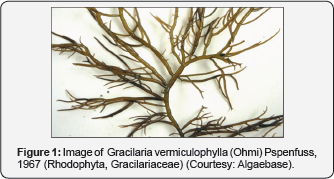
For the Dutch part of the Wadden Sea an inventory was made 7 years ago for invasion of the Wadden Sea for invasive exotic species in this estuarian sea including Gracilaria vermiculophylla (Figure 1) [1]. The Dutch Wadden Sea was investigated for twelve area’s subdivided in 83 locations in 2009 by GIMARiS [1]. This study was repeated in 2011 at the same locations, among else, in order to investigate if there was an increase in the spreading of non-indigenous invasive aggressive red seaweed G.vermiculophylla [2]. No significant increase in the incidence of invasive red drift over this two-year period in the Dutch Wadden Sea was found (see M & M) [2] whereas the German part and the Danish part of the Wadden Sea were at that time affected by a plague of these red algae resulting in overgrown mud flats. The risk of this macroalgae becomes clear from the work of [6] who placed G. vermiculophylla among the most potent invaders out of 114 non-indigenous macroalgal species in Europe.Over the past two decades several molecular studies have been performed of non-native seaweeds including cryptic invaders like this aggressive red drift algae considered as considered the most potent invaders out of 114 non-indigenous macroalgae species [6]. Although this study and the material we used [1,2] might presently AD 2017 be not a realistic reflection of the actual situation presently in the Dutch Wadden Sea we think this study might be useful for other researchers in its findings and its approach of "Ecological Systems Biology” lipidomics based approach we used.
In this research manuscript we first made a comparison if there was an interaction with other species via a statistical approach. We used a targeted approach using literature data in order to find known interactions of G.vermiculophylla with other aquatic species. From literature we found three interesting interactions.
- The global spreading of G.vermiculophylla has been suspected to result from its association with oysters [7,8].
- On the West coast of Sweden invasion of the non-vegetated soft sediment estuaries with G. vermiculophylla lead to an increase in abundance of small native invertebrates (e.g. gastropods and crustaceans) and epiphytic algae, with likely cascading effects on higher trophic levels [6].
- The mechanism is unknown, but epiphyte-host algae interaction and Ulva-Gracilaria interaction results in a reduction of Gracillaria sp. production [9].
The major question of this study is: which ecological suppressive mechanism in the Dutch Wadden Sea is operative on this red seaweed species G.vermiculophylla in this way preventing a resulting plague like in the German [5] and Danish Wadden Sea [8].
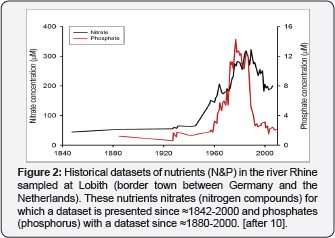
We propose the hypothesis of which one of these under a, b and c referred to ecological mechanisms which are located on the ecological suppressive mechanism for G.vermiculophylla. Several recent analyses suggest that primary production in the Dutch western Wadden Sea is limited by phosphorus (P), as a consequence of effective reducing policies. Because the Dutch Wadden Sea has an unique feature of its earlier mentioned ecological hydrodynamics with twice a day inflow of ≈15km3 North Sea water- for which the latter N & P are in great extent depend on river Rhine load- hence nutrient availability in the Dutch Wadden Sea is primarily determined by the river Rhine N & P load (Figure 2). This can be indicated by the N:P ratio for seaweeds found like in Europe P is the limiting factor in shallow coastal seas like e.g. the Mediterenean or the Northsea [10].
Research strategies are sometimes more a matter of serendipity than of conscious decision. Therefore, we hypothesize that P limitation has an effect on the seaweeds Ulva sp. in its suppression of G.vermiculophylla. This is a totally new perception but worth to test via LCMS measurements on the lipid fraction of Ulva sp. just like we earlier performed via a lipidomics approach using GCMS measurements at the Polyunsaturated Fatty Acid (PUFA) fraction of several seaweeds among else an Ulva sp. [10]. Our major aim of this study was to give for the western Dutch Wadden Sea a convincingly reasoning why G.vermiculophylla failed during the period 2009-2011 to repeat it success like this aggressive invader earlier could accomplish e.g. the German [5] and Danish [8] part of the Wadden Sea. But also we hope to find an ecological biomonitor in order for direct assessment and appropriate management in case there will be amble evidence for a G.vermiculophylla threat.
Meterials and methods
Collection ecological data
Overall overview of the total species numbers observed in the Wadden Sea inventory during the period July-August 2009 vs. July-September 2011 for dispersal of twelve area's subdivided in 83 locations at similar locations following a qualitative method generally applied by the Zoological Museum. Naturalis, Leiden University the Netherlands in detail described in [1,2].
Site selection and sampling
In the summer of 2011 (July through September) 96 locations in the Dutch part of the Wadden Sea were visited by a team of 3 biologists. A subset of these locations (n=52) had been sampled in 2009 as well. Locations were selected based on the presence of hard substrate such as piers in harbors, dikes, oyster- and mussel- banks. No a priori knowledge about the presence or absence of G.vermiculophylla was used as a selection criteria. At each location a qualitative assessment was made of all species present using a timed searching approach. Locations were characterized as sub-littoral or littoral, depending on whether they were submerged during high tide. G.vermiculophylla was almost exclusively found in the littoral area (2 sub-littoral findings in 2011) which is why the analysis focusses on the littoral area only. Species were identified using pictures made in situ and under a microscope. All macro-algae and ascidiacea were conserved using protocols of NCB "Naturalis”, Museum of Zoology, Leiden University, The Netherlands [1,2].
Species richness & Species composition
A comprehensive review of the enormous literature on interaction at all trophic levels between all kind of aquatic animal, plant (including micro- & macroalgae and seagrasses), as well as all microbial sp. within such a dynamic ecosystem like the Dutch Wadden Sea would be a daunting task. Therefore ecological "targeted” ecological statistical analysis was performed on relevant ecological interspecific relations in relation to the invasive drift algae G.vermiculophylla. Based on literature data on G.vermiculophylla interaction with other species we restricted ourselves to the following in the introduction mentioned three social interaction:
Taxonomy of Ulvaspecies
Taxonomy of this cryptic Ulvales genera was based on morphological traits [11,12] Ulvales typified by the family Ulvaceae, typified by the genus Ulva can further be delimitated to a number of species ranging from 25 up to 85 (www.algaebase. org 2012) [2].
Site selection and sampling
At each location we searched for organisms for at least 30 minutes. After 30 minutes, search was continued until the point it was estimated that finding a new species would imply a doubling of the searching time. At most locations 95% of the species were found within the first few minutes, leading to a search time of 45 minutes per location. Different methods were used to detect organisms: at low tide species were searched for using visual observations, stones and other materials were lifted up and under water nets and grabbers were used to sample under water. Additionally divers and remotely operated vehicles were used to search for new organisms.
Lipidomics
Using a lipidomics based approach [13-15] using LCMS techniques on one hand the major goal of the present work was to study features of the polar lipid fraction and fatty acid (FA) composition of total lipids from U.rigida as a function of a P-limited Dutch Wadden Sea ecosystem.
Mass spectrometry (LC-MS)
Lipids and free fatty acids (FFA) were analyzed with electrospray LC-MS. 10|il of the well mixed freeze dried tissue homogenate of pooled Ulva species powder (see further), which was extracted with 300|il of isopropanol (IPA) containing several internal standards (IS) like: C17:0 lysophosphatidylcholine (LPC), di-C12:0 phosphatidylcholine (PC), tri-C17:0 glycerol ester (TGE), C17:0 cholesterol ester (ChE) and C17:0 heptadecanoic acid (HDA). Samples were placed in an ultrasonic bath for 5 minutes. After mixing and centrifugation (10000rpm for 3 minutes) the supernatant was transferred to auto-sampler vial. This procedure was followed by injection of 10|i on the LC-MS Instrument (Thermo Electron, San Jose, USA). Lipids were separated on a 150 x 3.2mm i.d. C4 Prosphere column (Alltech, USA) using a methanol gradient in 5mM ammonium acetate and 0.1% formic acid (mobile phase A: 5% methanol, mobile phase B: 90% methanol). The flow-rate was 0.4ml/min and the gradient was as follows: 0-2min- 20% B, 2-3min- 20% to 80% B, 3-15min- 80% to 100% B, 15-25min- hold 100% B, 25-32min- condition at 20% B. The instrument used was a Thermo LTQ equipped with a Thermo Surveyor HPLC pump. Data were acquired by scanning the instrument from m/z 300 to 1200 at a scan rate of approximately 2 scans/s in positive ion ESI mode. The FFA LC-MS platform employs the same sample and similar HPLC conditions as the lipid method. The ammonium acetate concentration is 2mm instead of 5 mm and no formic acid was added. The gradient: 0-2min- 30% B, 2- 3min- 30% to 70% B, 3-10min- 70% to 100% B, 10-15min- hold 100% B, 15-20min- condition at 30% B. Detection of FFA is performed in negative ion ESI mode. Combined the two methods provide (semi) quantitative data for approximately 200 different identified lipids and FFA. Each extract was injected three times (10µl), once for the LC-MS FFA platform and two times for the LC-MS lipid platform. Furthermore, a quality control (QC) sample was prepared by pooling the samples. The pool was divided into 10µl aliquots that were extracted the same as the study samples. The QC samples were placed at regular intervals in the analysis sequence (one QC after every 10 samples). The QC samples served two purposes. The first is a regular quality control sample to monitor the LC-MS response in time. After the response has been characterized, the QC samples were used as standards of unknown composition to calibrate the data. In the homogenate to the 6 dominant lipid classes observed with these two methods are the lyso-phosphatidylcholines (IS used: C17:0 lyso-phosphatidylcholine), phosphatidylcholines (IS used: di-C12:0 phosphatidylcholine), sphingomyelines (IS used: di- C12:0 phosphatidylcholine), cholesterolesters (IS used: C17:0 cholesterol ester), triglycerides (IS used: tri-C17:0 glycerol ester), and free Fatty acids (IS used: C17:0 FFA). In addition to these lipids, the extracts also contain minor lipids, but these were either not detected (concentration too low relative to very abundant lipids like phosphatidylcholines and triglycerides) or they were not included in data processing. The LC-MS lipid and LC-MS FFA data were processed using the LC-Quan software (Thermo).
Statistics
Non-targeted approach
To test whether species richness differed between sites with and without G.vermiculophylla two analyses were conducted. First, the 34 littoral locations sampled in 2011 were divided in two groups based on the presence or absence of G.vermiculophylla. Difference is number of species between the two groups was assessed with a t-test. Because all locations were visited within a limited time frame this assessment minimizes changes in species number due to variation in time. Second, an inventory was made of locations at which G.vermiculophylla either appeared or disappeared between 2009 and 2011. The species richness in both years at those "switching locations" was between compared using a Welch test (because of unequal variances) was used to test for the equity of means. This approach minimizes the influence of spatial differences in geomorphology on species richness.
Targeted approach
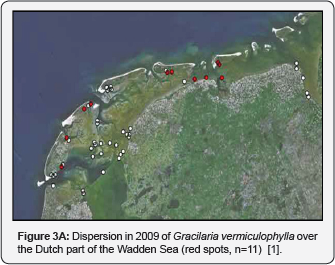
We restricted the working out of our comprehensive WDW surveys of 2009 vs. 2011 to a restricted our initial hypothesis if Ulva sp. in general could be found in the vicinity of G.vermiculophylla. In Figure 3 is the final DCA (De-trended Correspondence Analysis) depicted which is our ecological basis for further work out at the molecular level using a lipidomics approach the interaction between Ulva sp. and G.vermiculophylla. Using De-trended Correspondence Analysis (DCA) statistical techniques we have taken a closer look at the relationships (i.e. whether or not jointly preventing) G.vermiculophylla with:
- Mollusca sp.
- Grazers mainly Littorina littorea and
- Ulva sp.
Results are depicted below in the Results section in the form of a DCA (De-trended Correspondence Analysis). Although the three targeted inter-species relations within the western Dutch Wadden Sea ecosystem always highlighted different relationships we choose consequently for one lay-out of the DCA analysis in order to make a comparison feasible. Because G.vermiculophylla especially appears in the littoral area we zoomed in on this specific habitat issue (n=34 sites).
TNO-Lipidomics
Statistical methods specially developed, for application in biomedical research [16,17] using TNO- IMPRESS, EQUEST and WINLIN software were for the first time applied in this manuscript for the application of ecological/environmental issues.
Results
The 2009 dataset was mainly used to show that the distribution of G.vermiculophylla between the years 2009 and 2011 was not significantly increased as reflected in the comparison of Figure 3A (2009) vs. Figure 3B (2011) (Table 1).
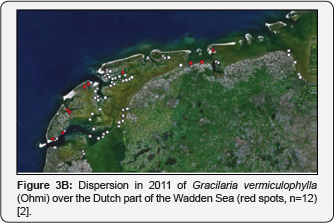
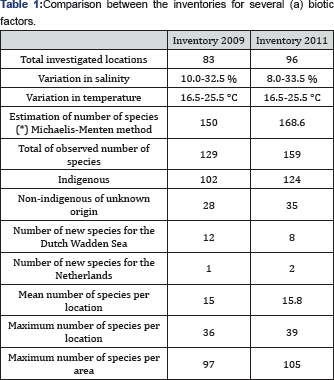
Non-targeted statistics
No difference in species richness was found between sites where Gracilaria vermiculophylla was present and sites where G.vermiculophylla was absent in 2011 (p=0.499), additionally no difference was found between locations where G.vermiculophylla was present in either 2009 and 2011 (p=0.331). It can be concluded from the applied statistics there is a clear difference between intertidal and sub-tidal locations which showed that there is a clear difference between the community at locations with and without G.vermiculophylla.
- Based on Detrended Correspondence Analysis (DCA) statistics related to bivalves the following tendencies can be found. The cockle (Cerastoderma elude) and elude Mussel (Mytilus edulis) seem reasonably associated with G.vermiculophylla while this for oysters less the case. It is indeed true that a lot of organic material is in the form of detritus (pseudo-faces) is excreted by the bivalves in mussel beds. For clams this is less the case because of different nutritional habits (Figure 4).
- Grazers: Literature mentioned for the Wadden Sea the grazer Littorina littorea -although not so effective- as major grazer of G.vermiculophylla in this coastal water (XX). In this respect should with special attention also be paid attention to the also lipid-omics based study at G.vermiculophylla and the biochemical reaction to (artificial) grazing. The ecological interaction between species in such a complicated ecosystem shouldn't solely be restricted to (a) biotic environmental factors related to photosynthetic efficiency [18] but also to (bio) chemical interaction between species or even within seaweed sp. That competition occurs which can be a controlling factor in the interaction of a Gracilaria dominated community. These patterns of seaweed interaction were observed in U/va-dominated seaweed communities [19] of the same genus like e.g. seaweed dominated communities by U/va sp. Our field data gave no strong indication of any ecological association between the grazer Littorina littorea and the seaweed G.vermicu/ophy//a but also to no other of the Littorina sp. (Figure 5).
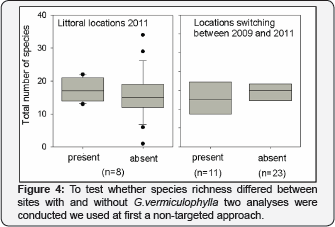

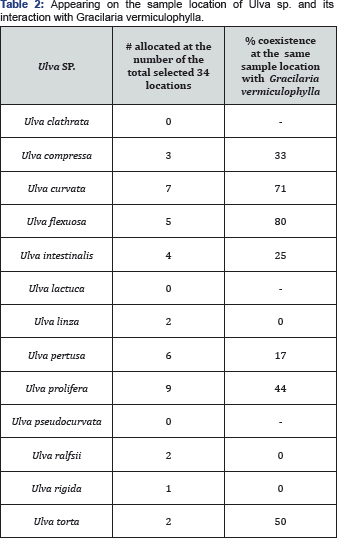
Table 2 and the DCA depicted in Figure 6A & 6B reflect that particular Ulva curvata and Ulva flexuosa often occur together with G.vermiculophylla. For the other Ulva sp. this is not the case. Why they occur together in the same area (habitat) is solely based on these ecological data difficult to say. From our statistical analysis of ecological species interaction of the very detailed and comprehensive data set of the ecosystem Wadden Sea a variety of Ulva sp. (Figure 6A & 6B) were always found in combination with G.vermiculophylla.


A first Detrended Correspondence Analysis DCA analyses showed that several U/va sp. are always close in the vicinity of G.vermicu/ophy//a especially on the first shaft (eigenvalue 0.23), and slightly less close to each other on the second shaft (eigenvalue 0.17). I.e., the types fairly often occur together. For both surveys [1,2] specific species delimitation of the genus U/va is problematic because of phenotypic plasticity mainly related to morphology which remains still a matter of debate [20]. We pooled the observations of the several U/va sp. using them as one clade based on the assumption that belonging to one genus U/va in principle basic similar fundamental biochemical principles should be maintained-also in a possible suppressive interaction with the seaweed G.vermiculophylla. Based on this solid major outcome of the statistical analyses of our comprehensive ecological dataset this gave a firm and sound basis in order for puzzling out at the (bio) chemical and molecular level the (Ulva sp. vs. G.vermiculophylla sp. Interaction)issue in order to clarify the causality of this ecological observation.
Lipidomics LCMS
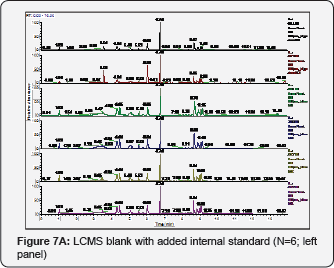
In Figure 7A six typical spectra of blanks are depicted while in Figure 7B six spectra of the Ulva homogenate are given. Our results clearly showed that the lipid profile of the pooled Ulva species polar lipids from the phosphorus limited western Dutch Wadden Sea, consisted of glycolipids (GL), phospholipids (PL), and the phosphorus-free betaine ester lipid 1,2-diacyl glycero-3-O-4-(N,N,N-trimethyl) homo-serine (DGTS) Mono- (MGDG) and digalactosyldiacyl glycerins (DGDG) in addition to sulfoquinovosyldiacyl glycerin (SQDG) were identified in the glycolipid (GL) fraction. The content of phosphorus-free lipid DGTS reached 4-6% of total lipids (Figure 7B). In this respect Ulva sp. from the Dutch Wadden Sea did not differ from the same plants from marine habitats and from phylogenetic related species of the genus Ulva in case of exemplified Russian studies at U.intestinalis (reviewed: [21]). In all instances the content of polar lipids was at the 89-95% level. The remainder were neutral lipids (NL) which we couldn't identified and named in the spectrum because of lack of standards. The phospholipid (PL) fraction contained phosphatidyl glycerol (PG), phosphatidyl ethanolamine (PE), phosphatidyl inositol (PI), diphosphatidyl glycerin (DPG), and phosphatidic acid (PA). The principal P-containing lipid in a quantitative sense was phosphatidylglycerol (PG), the content of which reached 79% of total phospholipids (PL). The principal phosholipid (PL) was phosphatidylglycerol (PG). It was also established that membrane lipids from these algae contained the betaine ester lipid 1,2-diacylglycero-3-O-4-(N,N,N-trimethyl) homo-serine (DGTS). The presence of mainly the betaine ester lipid 1,2-diacylglycero-3-O-4-(N,N,N-trimethyl) homoserine (DGTS) in the polar lipids of Ulva sp. under phosphorus restricted conditions in the Dutch Wadden Sea was a one of the major outcomes of this study (Figure 8A & 8B). The DGTS structures were reminiscent of phosphatidylcholine (PC) and usually appeared when the severely on a Phosphate nutrient relying cell wall structure PC were absent or present in small quantities [22]. The amount of phosphatidylcholine (PC) in our Ulva species sample from the P-limited Dutch Wadden Sea was important because the under phosphorus restricted conditions the concentration of Phosphatodylcholine (PC) will drop and will be replaced as structural component of the cell wall by the like also was observed in fungi grown under P-limited conditions [23].


Our LCMS results clearly showed that the lipid profile of Ulva species polar lipids from the phosphorus limited western Dutch Wadden Sea, consisted of glycolipids (GL), phospholipids (PL), and the phosphorus-free betaine ester lipid 1,2-diacyl glycero-3- O-4-(N,N,N-trimethyl) homo-serine (DGTS) (Figure 8A & 8B). Mono- (MGDG) and digalactosyldiacylglycerins (DGDG) in addition to sulfoquinovosyldiacylglycerin (SQDG) were identified in the glycolipid (GL) fraction. The content of phosphorus-free lipid DGTS reached 4-6% of total lipids (Figure 7B). Due to lack of appropriate seaweed lipidomics based standards- which is a completely new analytical research area- we couldn't quantify the small amount of lipids. We decided to publish these results as a first start towards lipidomics based seaweed technology.
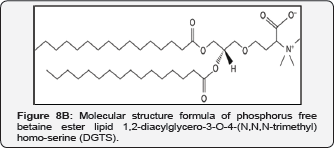
Discussion
Beatine lipids are ether-linked, non-phosphorous glycerolipids that resemble the more commonly known phosphatidylcholine (PC) in overall structure. PC once given the trivial name 'lecithin' is obviously the key building block of membrane bilayers in plants or seaweeds amounting ^50% of the total lipid cell membrane content [24]. Some of these organisms are entirely devoid of PC and instead a betaine lipid such as diacylglyceryl-O-4’-(N,N,N,-trimethyl)homoserine is biochemically produced. In mutants of the purple bacterium Rhodobacter sphaeroides -deficient in the biosynthesis of the betaine lipid- two genes essential for this process btaA and btaB were identified. It is proposed that btaA encodes an S-adenosyl- methionine-diacylglycerol3-amino-3-carboxy-propyl transferase and btaB an S-adenosylmethionine-dependent N-methyltransferase. Both enzymatic activities can account for all reactions of betaine lipid head group biosynthesis [25]. The betaine lipid diacylglyceryl-O-4’-(N,N,N,-trimethyl)homoserine was also detected by means of infrared spectrometry, 1H- and 13C-NMR spectrometry in the halo-tolerant microalga, Dunaliella parva (Lerche) [26] and equivalent reactions have been suggested by [25] for different pro- and eukaryotes. The latter is indeed confirmed by our measurements at the multicellular macroalgae of U/va sp. Based on these observations it seems plausible that orthologs of btaA/btaB may be present in other betaine lipid-containing organisms under similar phosphate limiting conditions in order to replace the essential cell wall component PC [21] reviewed the extensive russian studies at the lipid composition of U.intestinalis in relation to fluctuating environmental salinity. More specific, the growth of U.intestinalis in wide range of ecosystems with varying salinity conditions (from estuaries and salty rivers towards marine waters, from freshwater 0% towards saltwater 32%) had been studied for U.intestinalis. It became clear that the lipid composition of U.intestinalis was directly dependent on salinity stress. In these studies for U.intestinalis it was shown that glycolipids (GL) and phospholipids (PL) comprised the main part of acyl lipids in lipids of this species from marine habitats. Differences in growth efficiency of this eurybiotic seaweed were related to the absence of phosphatidylcholine (PC) in the phospholipid fraction (PL) and the appearance of this DGTS which could be considered as a manifestation of the adaptation of this eurybiotic species to various salinities.
In orderto introduce anlipidomics based ecological biomarker -like in this study DGTS in Ulva sp.- the fundamental principles of its role the structural and functional significance, localization within the cell, and biosynthesis pathway of polar lipids from fundamental perception needs to be understood. According to current thinking, Mono- (MGDG), digalactosyldiacylglycerins (DGDG) in addition to sulfoquinovosyldiacylglycerin (SQDG) and phosphatidylcholine (PG), solely restricted to the glycolipid (GL) fraction were the dominant structural elements of the chloroplast membranes. Both lipids of the phospholipid (PL) and DGTS fraction resemble lipid compounds of the non-plastid endo-membranes [27] DGTS, phosphatidylcholine (PC), and phosphatidylethanolamine (PE) were rather rarely encountered simultaneously [28].
For example, all three lipids were detected in eustigmatophytes of Nannochloropcis sp. [29] and Monodus subterraneus [30]. However, DGTS appeared more often with phosphatidylcholine (PC) or phosphatidylethanolamine (PE). Thus, lipids of Chlamidomonas reinhardtii contained PE and DGTS [31] whereas both PC and DGTS were found in Dunaliella salina [32]. Our results showed that the PL of a single alga species can contain simultaneously the three a fore mentioned lipids (DGTS, PG and PE), and that PC can be present or absent under phosphorus limited conditions in the Dutch Wadden Sea.
The Polyunsaturated Fatty Acids (PUFAs) are indisputable a most extreme cell wall component of seaweeds. This topic, has been earlier worked out in a lipidomics based study using GCMS- techniques [33]. With this study at "ecological systems biology level" we hope to provide management tools via the (Ulva sp. vs. G.vermiculophylla) interaction to avoid any further "success" of this extremely aggresive invasive red drift algae and its ability to overgrow whole ecosystems including their whole native population. Also, we hope this lipidomics based compound and rare betaine lipid diacylglyceryl-O-4'-(N,N,N,-trimethyl) homoserine (DGTS) can serve as an ecological biomarker in order to protect vulnerable ecosystems like the Wadden Sea (UNESCO World Heritage).
Conclusion and and Perspectives
We succeeded in this complex research study to unravel some parts of the Gordian knob but much topics remain open for future research. Achievements we performed and suggestions for future research are:
- First to show for this complex ecosystem, using a statistical approach on the datasets of [1,2], that Ulva seaweeds always occur near G.vermicu/ophy//a, what opens a new research area related to seaweed competition [18,19] also called allelopathic interactions between seaweed species [33,34].
- Secondly, we found a biomarker for growth of U/va sp.- a rare betaine lipid solely found in eukaryotes [23] under phosphate limited conditions also named rare betaine lipid diacylglyceryl-O-4’-(N,N,N,-trimethyl)homoserine (DGTS)- where possible G.vermicu/ophy//a not is capable too. This is a topic for further research.
- Third, we need appropriate standards specific for the lipids which can be found in U/va sp. seaweeds and can learn from the Russian research on this topic [21].
- Fourth, the answer to our major question why the Dutch Wadden Sea during the time interval of 2009-2011 was not overgrown with G.vermicu/ophy//a while it was in German [5] and Danish [8] Wadden Sea a plague can to our perception solely be ascribed to the phosphorus load of the rivers in those Wadden Sea areas. The river Rhine feeds mainly the Dutch Wadden Sea and has a low P-load (Figure 2). In Germany and Denmark other rivers feed that part of the Wadden Sea with probably a high P-load. This topic is still a speculation and the major question of this research remains open for debate and future research.
To Know More About Journal of Oceanography Please Click on: https://juniperpublishers.com/ofoaj/index.php
To Know More About Open Access Journals Publishers Please Click on: Juniper Publishers
Comments
Post a Comment